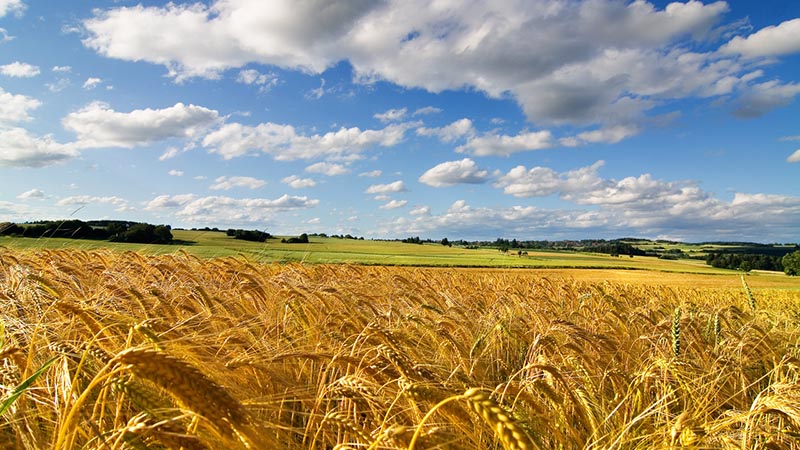Homeland of wheat: where did wheat come from on Earth
For many centuries, wheat has determined the food security of entire states. To this day, it is the staple food of millions of people. Where did this culture come from and how long has it captured the food market of the planet? Read about the origin of wheat on Earth in our article.
The content of the article
How wheat came and where it came from

History wheat originates from the Middle East region known as the Fertile Crescent. It covers modern Israel, Iraq, Palestine, Syria, Lebanon, Egypt, Jordan, the outskirts of Turkey and Iran. It was there in 12 thousand BC. e. primitive people began to eat a wild plant, which became the ancestor of modern wheat.
The wild-growing cereal fell off immediately after ripening; moreover, the grain was poorly cleaned from the shell, which made its processing labor-intensive.
Ancient farmers gradually domesticated the culture by selecting the best seeds. The earliest archaeological finds of cereal date back to 10 thousand BC. e. They were found in the Karakadag mountainous region of modern southeastern Turkey.
From the archaeological material left by nomads in Western Asia, the researchers learned that people, having learned to use grain, gradually moved from hunting animals to collecting seeds for food.
Reference. Wheat completely changed the way of life of primitive man, predetermining the transition from hunting and gathering to agriculture. This happened about 9 thousand years ago and was called the Neolithic revolution.
Ancient farmers dried, threshed grains, boiled over low heat and cooked flat cakes. Initially, the grains were eaten raw, after which they began to grind them with stones, receiving coarse flour, from which they cooked a kind of porridge. Such a primitive kind of processing is a prototype making flour and baking bread.
In its primordial form, bread was a slurry of half-raw seeds. Such cakes are found among the peoples of Africa and in some Asian villages.
For centuries, farmers continued to take seed samples from their fields that showed the best signs - ease of collection, yield, resistance to weather conditions, - and the new wheat began to dominate.
Soft
Center of origin soft varieties wheat (Triticum aestivum) is considered the southern part of modern Turkey. The earliest finds date back to 7 thousand BC. e. This type of cereal is the result of cross-pollination of ancient forms of wheat and wild grasses. The hybrid immediately showed good yieldthan attracted the attention of early farmers.
Today, soft wheat accounts for more than 90% of the world's crops.
Solid
The region of origin of durum wheat (Triticum durum) is not precisely determined. Scientists predominantly call the Mediterranean region its homeland, since it is here that an exceptional variety of its varieties and varieties was found.
The introduction of this cereal into agriculture occurred in 4–3 thousand BC. e. In the world volume of wheat production, the share of durum varieties is about 5%.
Spring and winter

Winter and spring crops are represented by both soft and hard varieties.
Our ancestors living in regions with mild winters and high snow cover discovered the benefits of planting wheat in the fall. The advantages of this method are that you can use the moisture obtained as a result of melting snow for growth and achieve earlier ripening times compared to spring planting.
For centuries, using folk selection methods, winter varieties of cereal were bred, the most frost-resistant and able to withstand a sharp change in weather conditions were selected. This is how winter wheat.
The first report on the cultivation of winter cereal crops in Russia in the Caucasus dates back to the middle of the 19th century.At first, due to the low resistance to frost of winter varieties in Russia, spring forms of durum wheat... Today, mostly winter varieties have been bred and grown.
Before the onset of the winter cold, winter crops have time to germinate and take root well, and with the arrival of spring they continue their life cycle, ripening earlier than spring crops.
In those regions where winter crops are not damaged by frost, they are usually preferred as much more productive.
Crops of spring varieties prevail in the northeastern regions of Russia.
The main differences between spring and winter crops:
- Winter varieties are sown in early autumn, spring varieties in mid-spring.
- Winter crops are much superior to spring crops in yield, but inferior in baking properties.
- Spring absorbs nutrients from the soil more intensively and is resistant to droughts.
- Winter crops are well resistant to abrupt changes in weather conditions, but they are more demanding on the quality of the soil.
Wheat in Russia

The Slavs, who from time immemorial inhabited the territory of modern Russia, were mainly engaged in agriculture. The main crops cultivated were:
- wheat - mostly in the south;
- rye - in the north;
- barley - in the very north of the agricultural zone, in harsh climatic conditions.
When they began to grow
Wheat appeared in Russia in the 5th century BC. e. This is one of the very first cereals grown by Indo-Europeans, including the Slavs. Our ancestors borrowed it from the Goths who lived in the south of Eastern Europe. The word "bread" comes from the Gothic Hlaifs.
Wheat was one of the first crops grown by the Slavs. It is mentioned in the earliest written records. But rye appeared on our lands only in the XI-XII centuries. This is evidenced by the records of Nestor the chronicler and materials from archaeological excavations in Novgorod. However, due to its resistance to the unfavorable northern climate, rye very quickly spread in the territory of present-day Russia. However, in the southern regions, wheat invariably prevailed.
What species were grown
The Slavs did not grow the wheat that we are accustomed to today. They sowed one of its ancient species - spelled. It is a semi-wild cereal, a relative of durum wheat. It is called "two-grain". The spelled grain is covered with several layers of film.
Whole spelled grains, crushed and ground, were more often boiled. This is where the Russian name "wheat" comes from - from the Old Slavic root * ršen - "shove", "crush", "rub". This word is often found in ancient Russian written records of the 11th century.
Today all over the world there is a revival of interest in this ancient culture. Its high fiber content along with low gluten content makes prehistoric wheat ideal for a healthy and hypoallergenic diet.
Spreading culture to other regions
The Neolithic Revolution quickly pushed wheat beyond its homeland.
The spread of cultivated cereals from the Fertile Crescent region took place as early as 9 thousand BC. e., when he appeared in the Aegean region.
Wheat came to India about 6 thousand BC. BC, and to Ethiopia, the Iberian Peninsula, the British Isles and Scandinavia - no later than 5 thousand BC. e.
At the same time, this plant became known in Northern Greece, Macedonia and Northern Mesopotamia. After about 1000 years, wheat reached China.
On the territory of present-day Eastern Europe, it appeared by 6 thousand AD. e.
Some scientists believe that the domestication of the grain crop took place in different regions at about the same time, but the facts refute this. Archaeological evidence for its early domestication is lacking anywhere other than the Middle East region.
By the beginning of our era, the culture had spread throughout Asia and Africa, and during the period of the Roman conquests, it began to be grown in different parts of Europe.
In the South, and later in North America, the cereal was brought in by European colonists in the 16th-17th centuries, and only in the 18th-19th centuries - to Canada and Australia. This is how wheat spread throughout the planet.
Reference. The old wheat varieties bred in Russia have become widespread and have become the starting material for the development of a number of varieties in other countries. Many winter varieties exported from our country have retained their Russian names in the USA to this day: Kharkovskaya, Beloglina, Odessa, Krymka.
Wild ancestor of wheat

The origin of the cereal can be traced back to the wild herb of the Triticeae family, which appeared 75 thousand years ago. This herb is the oldest ancestor of wheat.
The earliest harvested wheat was a wild spelled in the eastern Mediterranean, which is about 12 thousand years old.
The seeds of the plant were to the taste of primitive people, they began to be used for food. The materials of archaeological excavations indicate that in 10 thousand BC. e. our ancestors have already cultivated great wheat. The ears of the ancient cereal were brittle, and the grains were small and easily crumbled immediately after ripening, so it was impossible to collect them. Therefore, people had to use unripe grains for food, without waiting for them to fall.
For millennia, ancient farmers cultivated and selected wild grasses to domesticate the cereal. The cultivation took place very slowly: according to archaeologists, about 6,500 years ago, wheat was gradually domesticated.
The cultivation, re-collection, selection and sowing of wild grass seeds has led to the creation of new varieties, the grains of which are larger, more resistant to shedding and much more convenient to collect and further processing. The grains of cultivated wheat in an ear are firmly held until they are knocked out during threshing.
Because of this ear strength, domesticated wheat has lost its ability to reproduce without the help of humans. Its ubiquity is the work of man.
Conclusion
The origin of the grain culture can be traced back tens of thousands of years with an accuracy of several tens of kilometers. People helped her to conquer the planet, and today no cereal has as many species and varieties as wheat. But, despite this diversity, its primitive varieties are still very popular with supporters of healthy eating.